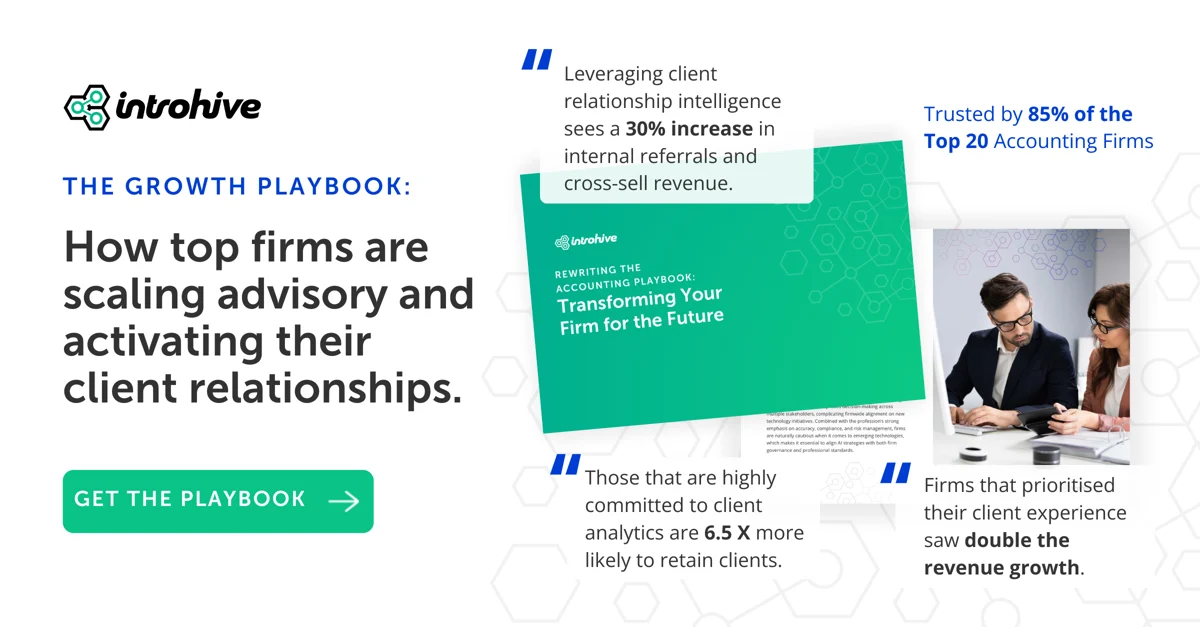As accounting firms look to growth in 2025, mergers and acquisitions remain a key strategic lever. But for many, the real work begins after the deal is signed. Growth isn’t just about expanding into new markets or adding services. It is about aligning people, processes, and priorities to deliver on the full promise of the merger, including effective post-merger synergy creation that turns strategic intent into operational reality
That theme was front and center during a recent panel at the AAM Summit (‘Unlocking Post M&A Growth’), where Eric Majchrzak, CEO & Chairman at BeachFleischman, Kristen Lollar, CMO at Whitley Penn, and Rob Lightman, Director of Business Development at Withum, joined moderator Adam Klein, Head of Industry, Accounting and Advisory at Introhive for a candid conversation on what it truly takes to grow after a deal. Drawing on lessons from multiple acquisitions, they shared how firms can move beyond the mechanics of the transaction and focus on the strategic alignment needed to drive meaningful, measurable growth.
Table of contents

Here are five takeaways that stood out.
1. Growth strategies only works if everyone understands the “why”
Successful acquisitions start with a shared understanding of purpose and that clarity has to come from the top. Everyone across marketing, business development, and leadership needs to be aligned on why the deal was done and what it’s meant to achieve. As Eric put it, “You absolutely 100% have to know the why behind that transaction: is it to enter a new market, is it to gain a new service capability, maybe a new industry capability?”
When the strategic purpose is clearly communicated, teams are better equipped to align their efforts, whether that’s marketing shaping the right message, business development identifying new opportunities, or leadership guiding the integration. Clarity at every level helps ensure that each function is contributing toward the same overall goal, including the post-merger synergy creation that unlocks real value beyond the balance sheet.
Over the course of seven acquisitions since 2019, Eric and his team have steadily improved their approach to communication and have come to recognize that effective integration depends on more than just executing a plan. It requires making the strategy visible and meaningful across the entire organization.
As Kristen and Rob added, this clarity also needs to extend to the acquired teams, including a clear understanding of their future role, their place in leadership, and how they fit into the bigger picture. Without that, integration becomes far more challenging and can delay key functions like business development, which, as Rob noted, often does not fully engage until six to nine months after a deal closes because the foundational alignment and operational clarity are still being worked out.
2. Marketing’s role is to reframe, not just rebrand
After a deal closes, marketing’s role goes far beyond updating logos or announcing the transaction. As Kristen explained, the real challenge is helping clients build comfort with the new firm, especially when their trust is rooted in a long-standing relationship with the legacy brand.

“It’s just taking that conversation and making them comfortable with the new firm: same people, new firm, and broader resources,” she said. That comfort doesn’t come from a one-size-fits-all campaign. It requires a tailored approach based on how different clients consume information and where they are in the relationship. Some clients may respond to thought leadership or industry events, while others need face-to-face interactions with people they already know.
Marketing plays a key role in this education process, whether through social media, targeted communications, or client meetings – ensuring that the message is delivered in a way each client can receive. The objective isn’t just to refresh the brand, but to reframe the relationship in a way that builds confidence in the firm’s expanded capabilities and continuity of service. This client education also supports the broader post-merger synergy creation process by helping internal and external stakeholders align around the combined firm’s value.
3. Business development thrives on post-deal alignment and post-merger synergy creation
As Rob explained, early integration efforts typically prioritize operational alignment, systems, and communication. Business development enters once there’s a clear understanding of where the new firm’s capabilities fit and where growth potential exists.
“With the structure that we have, I’m not usually involved until at least six to nine months after the acquisition,” Rob said. “There’s so much there like software and day-to-day operations that needs to be figured out first.”
This delayed engagement enables more strategic deployment. In some cases, the acquisition enhances an already strong industry vertical, and Rob focuses on placing the right business developer to help deepen client relationships and drive growth within that segment. In others, the acquired firm brings deep specialization in one area, but leaves room to build out additional services. In those situations, Rob works closely with firm leadership to identify where and how to introduce new offerings, strategically positioning BD professionals to support that expansion.
This isn’t about sending generalists into a new territory. It’s about deploying the right people, with the right focus, at the right time and grounding it in the deal’s strategic intent. Whether it’s expanding a specialty or broadening services in a new geography, business development becomes a lever for purposeful growth once the foundation is in place.

4. Taking a data-driven approach helps turn cross-selling potential into opportunities
Cross-selling is one of the biggest levers for post-acquisition growth, but it requires more than just offering new services. As Adam observed, “In every transaction I’ve been a part of, we talk about the market… but one of the real big outcomes we’re looking for is that white space, cross-selling opportunity.” Clients may have long-standing relationships, but those relationships often involve only a fraction of what the combined firm can now deliver.
Eric emphasized that capturing those opportunities starts with internal alignment and deal-specific metrics. “Start looking at maybe like a gap analysis of the incoming clients – how are they being served by that firm that we merged in, and where are the opportunities that we can layer on top of that.” But it’s not just about identifying gaps. Eric stressed that post-deal KPIs should be tied directly to the strategic intent of the acquisition, not generic growth benchmarks. Whether the deal was about entering a new market, expanding a service line, or deepening an industry focus, teams need clear, measurable goals that reflect that purpose. That clarity helps teams prioritize, stay focused, and understand how their work drives integration success.
Kristen shared how marketing supports this process with both data and insight. Her team uses CRM platforms and relationship intelligence tools like Introhive to run historical analyses on email activity and engagement. This helps them understand who has strong relationships, what industries are represented, and where cross-sell opportunities might exist. From there, marketing builds targeted campaigns (email sequences, personalized content, or relationship-driven outreach) to introduce clients to new capabilities and reinforce the value of the combined firm.
But data alone isn’t enough. Turning insight into results depends on how well relationship leads are supported with the right tools, messages, and timing. Effective cross-selling is not just about having more to offer, it’s about creating clarity, consistency, and confidence across every client touchpoint.
5. AI and automation are reshaping how firms scale after a deal
Artificial intelligence and automation are beginning to shift how firms approach post-acquisition growth. While the technology is still evolving, panelists shared early examples of how it’s helping teams move faster and operate more strategically in areas like due diligence, marketing, and business development.
Eric noted that AI is already reducing the time required for early M&A tasks. Tools that can analyze data sets quickly allow leadership to make more informed decisions and stay focused on strategy. “It’ll allow us to focus higher on the strategy and implementation,” he explained, rather than getting lost in time-consuming detail.
On the marketing side, Kristen explained how tools like Microsoft Copilot can now generate campaigns, SEO strategies, social templates, and presentations in minutes – work that used to take weeks. This shift is prompting her team to rethink talent needs. “Do we need to upskill some of our current team members, and what skills do we need to have for new ones coming in?” she asked. While the potential is exciting, she acknowledged the pace of change isn’t for everyone. “It’s incredibly fast, and for some on our team, it’s not going to be what they want to do for the future. But that’s okay, it just creates opportunities for growth.”
Rob emphasized that AI is already proving useful for business development, particularly when entering unfamiliar industries or regions. It gives his team a faster way to develop strategic insights and build a foundation of knowledge, helping business developers ramp up with more confidence and direction.
While AI won’t replace the human relationships at the heart of professional services, firms that apply it with intention and support their teams through change will be better positioned to scale effectively after a deal.
Post-M&A success isn’t about what you added. It’s about what you unlock via post-merger synergy creation.
Post-acquisition growth doesn’t happen by default. As the panel made clear, it takes strategic alignment, deliberate communication, and a clear understanding of where value can be created.
Whether it’s marketing helping clients feel confident in the combined firm, business development knowing where and when to engage, or leadership setting deal-specific success metrics, integration works when everyone understands the “why” behind the deal and how their role supports it. And that shared understanding comes from real data about client relationships, service gaps, and opportunities, and from teams working together to put that information to use.
As Adam shared, “In every transaction I’ve been a part of, we talk about the market… but one of the real big outcomes we’re looking for is that white space, cross-selling opportunity.” He reflected on how, early in his career, firms often trusted assumptions about cross-sell potential. Today, that approach has shifted. Firms are using analytics, automation, and objective evidence to evaluate whether there is real opportunity, not just cultural fit, but data-backed potential to sell new services or scale existing ones. Eric added that better data leads to greater transparency, enabling smarter decisions from day one.
To explore how firms are modernizing their M&A approach from the very start, check out our blog on data-driven due diligence.
Or book a demo with our team to learn more.



